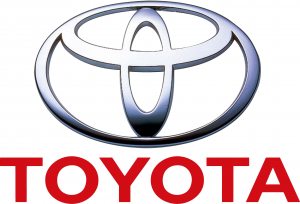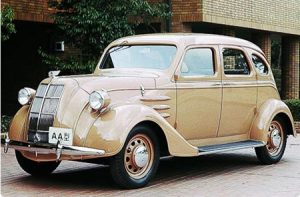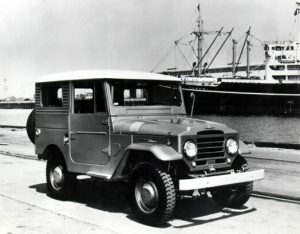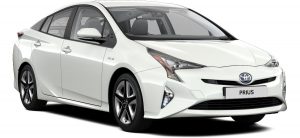 Think of Toyota, and you’re probably thinking of one of the world’s largest and most successful car companies ever made. So it’ll probably come as a bit of a surprise to learn that even though they’re mostly known for their cars, they still exist in the textile business, as well as the automatic loom production one. Everything is computerized now, with electric sewing machines and less actual staff, but the point still stands. We’re not here to talk about that however. We’re interested in the automotive portion of Toyota, so let’s focus on that instead.
Think of Toyota, and you’re probably thinking of one of the world’s largest and most successful car companies ever made. So it’ll probably come as a bit of a surprise to learn that even though they’re mostly known for their cars, they still exist in the textile business, as well as the automatic loom production one. Everything is computerized now, with electric sewing machines and less actual staff, but the point still stands. We’re not here to talk about that however. We’re interested in the automotive portion of Toyota, so let’s focus on that instead.
Toyota started out life as a division of the back-then successful Toyoda Automatic Loom Works in 1933. The founder’s son, Kiichiro Toyoda, directed the entire company, including the heading of the cars they were producing. Prior to actually starting the production, he travelled to Europe and the U.S. in 1929 to inspect the rest of the world’s automotive productions and their assembly lines. By 1930 he had already begun researching gasoline-powered engines for their own personal use. The war between Japan and China was heating up, so the Japanese government actually encouraged Toyoda Automatic Loom Works to start building cars to increase domestic production. A year after they founded it, in 1934, they produced the first Type A engine, which was implemented in the first Model A1 passenger car. The earliest cars were somewhat similar to the Dodge Power Wagon, but the reason for that is very simple. They actually had interchangeable parts.
The Name
 Toyota Motor Co. officially separated from the rest of Toyoda in 1937, when it became an independent manufacturer. The name change from Toyoda to Toyota was due to the fact that the Japanese symbol for the word went from Kanji to katakana giving it 8 letters. In East Asian culture, the number 8 is considered lucky, so Toyota decided to go with that. During the great Pacific War (essentially World War II), the company started making trucks for the Imperial Japanese Army. The demand for trucks was greater than the actual production, as Toyota was basically the largest and only provider. To make as many as possible, they had to keep the trucks simple and bare. They didn’t even come with two headlights, but rather a single one in the middle of the hood. A scheduled Allied bombing was planned to shut down the Toyota factories in Aichi and completely cripple Japan, but the war thankfully ended long before that.
Toyota Motor Co. officially separated from the rest of Toyoda in 1937, when it became an independent manufacturer. The name change from Toyoda to Toyota was due to the fact that the Japanese symbol for the word went from Kanji to katakana giving it 8 letters. In East Asian culture, the number 8 is considered lucky, so Toyota decided to go with that. During the great Pacific War (essentially World War II), the company started making trucks for the Imperial Japanese Army. The demand for trucks was greater than the actual production, as Toyota was basically the largest and only provider. To make as many as possible, they had to keep the trucks simple and bare. They didn’t even come with two headlights, but rather a single one in the middle of the hood. A scheduled Allied bombing was planned to shut down the Toyota factories in Aichi and completely cripple Japan, but the war thankfully ended long before that.
Postwar period
 Japan was arguably the most devastated country after the War. Economic growth was nonexistent, with even the most prominent of companies struggling to survive. None the less, production continued with the 1947 SA model. The lack of sales meant that the company was nearly bankrupt by the end of 1949, just 2 years after production reopened. Eventually Toyota was able to put stand back up on its feet thanks to a loan from a large consortium of banks. A year later however, the same happened again. In June of 1950, they only sold 300 trucks. That’s right, they managed to sell just 300 in the all of Japan. Management announced wage reductions and even layoffs, putting the union on strike. The entire ordeal lasted two months, before finally coming to agreements. Soon after that Kiichiro Toyoda left, and in his place came Taizo Ishida, the CEO of Toyoda Automatic Loom.
Japan was arguably the most devastated country after the War. Economic growth was nonexistent, with even the most prominent of companies struggling to survive. None the less, production continued with the 1947 SA model. The lack of sales meant that the company was nearly bankrupt by the end of 1949, just 2 years after production reopened. Eventually Toyota was able to put stand back up on its feet thanks to a loan from a large consortium of banks. A year later however, the same happened again. In June of 1950, they only sold 300 trucks. That’s right, they managed to sell just 300 in the all of Japan. Management announced wage reductions and even layoffs, putting the union on strike. The entire ordeal lasted two months, before finally coming to agreements. Soon after that Kiichiro Toyoda left, and in his place came Taizo Ishida, the CEO of Toyoda Automatic Loom.
The Korean War, as bad as it was, kick started the company yet again, as the US ordered some 5,000 vehicles from Toyota. Taizo focused on making more Toyota plants, which ultimately gave the company an edge over rival Nissan during the 1960s. The Toyota Crown became the first Japanese vehicle to be exported to the U.S. in 1957.
Modern-day Toyota
 Today, Toyota is thriving in large sale numbers, but the most recent troubles date back as recent as 2008. During weak US economy in 2008, Toyota announced that their numbers have been slowly but surely declining. The same thing happened with the Detroit Big Three. The reason was simple: the Tundra wasn’t selling in the needed numbers, and neither were the Prius, Corolla or Yaris. Fast forward some 5 years later, and everything’s changed yet again. The high demand of hybrids put the Prius back on the radar for lots of potential buyers, and the increase in pickup demand meant the affordable Tundra became an option for many people.
Today, Toyota is thriving in large sale numbers, but the most recent troubles date back as recent as 2008. During weak US economy in 2008, Toyota announced that their numbers have been slowly but surely declining. The same thing happened with the Detroit Big Three. The reason was simple: the Tundra wasn’t selling in the needed numbers, and neither were the Prius, Corolla or Yaris. Fast forward some 5 years later, and everything’s changed yet again. The high demand of hybrids put the Prius back on the radar for lots of potential buyers, and the increase in pickup demand meant the affordable Tundra became an option for many people.
If there’s one thing Toyota’s known for, it’s safety, and the vast amount of resources they’ve been spending lately into researching said qualities only further solidifies that. The state of the art advanced safety systems, both passive and active, have been implemented by most other manufacturers by now, but the truth is Toyota started the entire trend.
It’s impossible to mention Toyota without ushering the words reliability and quality. As a company, they’re probably the most well-diverse one there is. Just think of their model lineup. They offer a dozen hybrids, lots of economic city cars, a few pickups and SUVs, and if you’re after speed and fun, there’s even the GT86 with the newly-announced Supra successor on the way. It’s really difficult to think of a company which is better rounded than Toyota. We sincerely hope they continue doing their own thing, because it seems to be working. We can’t wait to see what the new Supra successor will bring, but more importantly, what Toyota has planned for the future of the automobile as a whole.

